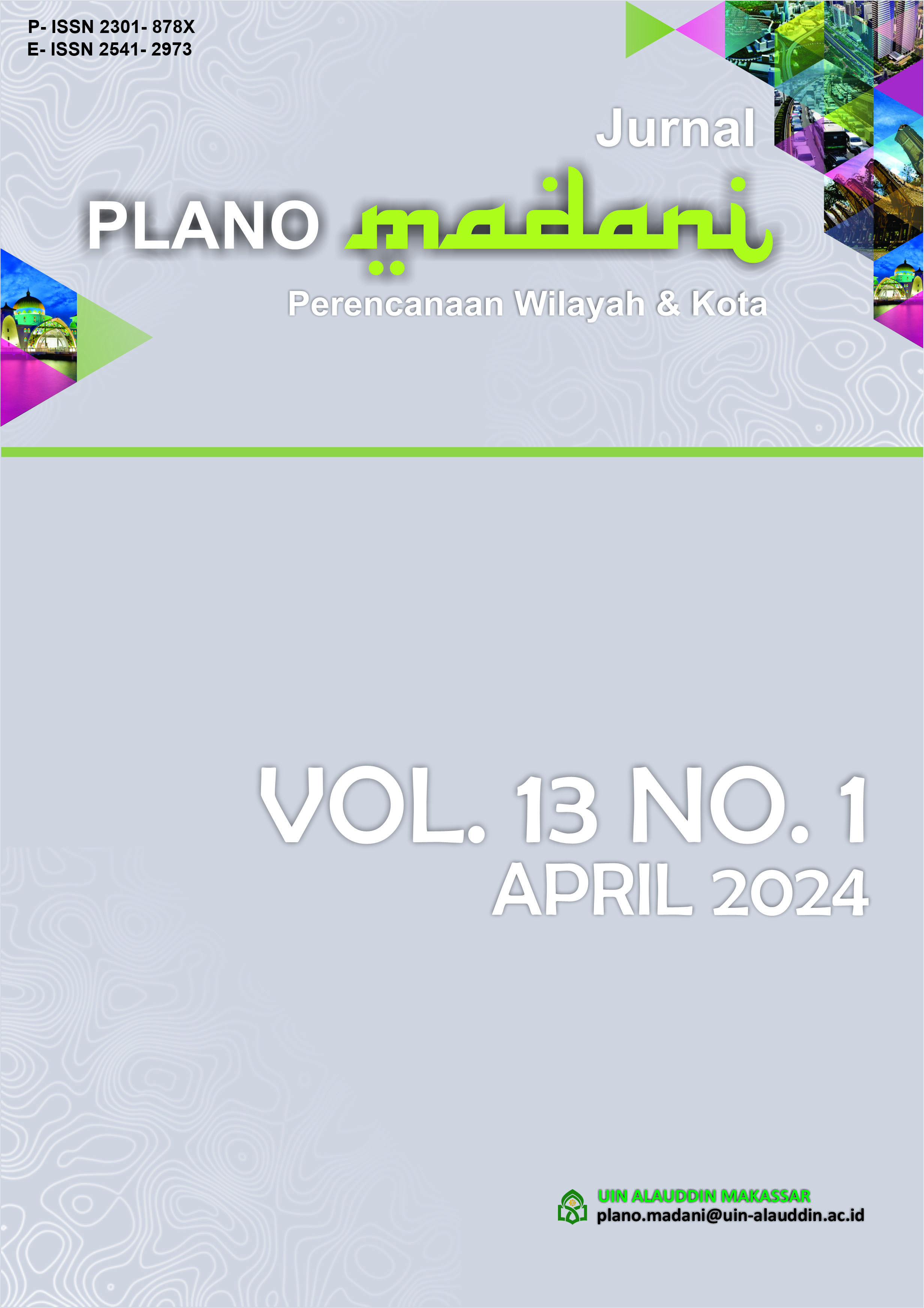EVACUATION STRATEGY IN BUILDING TSUNAMI DISASTER RESILIENCE FOR INDUSTRIAL FACILITIES IN THE CITY OF CILEGON
Abstract
The city of Cilegon is located in the province of Banten, situated at the western tip of Java Island and serving as a connecting area between Java and Sumatra. It plays a crucial role in the development of national strategic industries. Additionally, Cilegon faces a high level of disaster risk, particularly from the threat of tsunamis along its coastal areas bordering the Sunda Strait, as well as high vulnerability to industrial disasters. Therefore, an effective evacuation strategy is being implemented as part of efforts to build resilience against disasters. This research adopts a quantitative approach, utilizing scoring methods to determine the final outcomes. The technical approach involves using ArcGIS software to aid in scoring processes through Attribute Tables, resulting in spatial maps such as tsunami hazard maps, collateral hazard maps, and evacuation plan maps. Subsequently, disaster risk reduction strategies will be formulated. Four districts in Cilegon are affected by tsunamis: Ciwandan, Citangkil, Grogol, and Pulomerak. Ciwandan and Citangkil districts have a high tsunami hazard index, while Grogol and Pulomerak districts have a moderate hazard index, with Pulomerak district having the highest inundation area. The largest submerged industrial facilities include parking lots and warehouses, with a total submerged industrial area of approximately 329 hectares. The Estimated Time of Evacuation (ETE) exceeds the Estimated Time of Arrival of the Tsunami Evacuation Wave (ETA-TEW) in several districts, namely Ciwandan, Grogol, and Pulomerak. Citangkil, Grogol, and Pulomerak districts still lack evacuation places, so six new evacuation locations are planned in Cilegon city.
Downloads
References
Ayres, A., & Calkins, T. (1977). Acoustic position measurement systems. In in: Oceans ’77 Conf. Record, Third Annual Conf. on Oceanic Engng., (Los Angeles, U.S.a.: Oct.17-19, 1977) (Vols. 2, New York, U.S.A., Inst. Electrical & Electronics Engrs. Inc.; Washington, D.C., U.S.A., Mar. Techn). https://doi.org/10.1109/oceans.1977.1154316
Bilqis, R. S. A. (2023). Analisis Bahaya Bencana Tsunami di Kota Cilegon Menggunakan Sistem Informasi Geografis. Universitas Diponegoro, 2504, 1–9.
BNPB. (2012a). Menuju Indonesia Tangguh Menghadapi Tsunami. Masterplan Pengurangan Risiko Bencana Tsunami, 146. https://bnpb.go.id/uploads/migration/pubs/578.pdf
BNPB, R. (2012b). Peraturan Kepala Badan Nasional Penanggulangan Bencana (BNPB) Nomor 02 Tahun 2012 Tentang Pedoman Umum Pengkajian Risiko Bencana. Jurnal Ilmu Tanah Dan Lingkungan, 16(2), 67. https://doi.org/10.29244/jitl.16.2.67-74
BPBD. (2022). Upaya Kesiapsiagaan Hadapi Bencana. Bpbd.Jogjaprov.Go.Id. http://www.bpbd.jogjaprov.go.id/berita/upaya-kesiapsiagaan-hadapi-bencana
BPS Kota Cilegon. (2022). Kota Cilegon Dalam Angka 2022.
Harsono, P., & Suflani, S. (2018). Identifikasi Potensi Dan Manajemen Pencegahan Bencana Industri Di Kota Cilegon Provinsi Banten. Jurnal Administrasi Publik, 9(2), 153–180. https://doi.org/10.31506/jap.v9i2.4760
Khansa, T. A. (2022). Pemetaan Tingkat Risiko Bencana Tsunami di Wilayah Pesisir Kota Cilegon. Universitas Pendidikan Indonesia, 29–53.
Kota Cilegon. (2023). Profil Kota Cilegon. Biropemotda.Bantenprov.Go.Id. https://biropemotda.bantenprov.go.id/index.php?/profil-kota-cilegon
Pasaribu, L. P., Apsari, N. C., & Sulastri, S. (2023). Kolaborasi Penta Helix Dalam Penanganan Pasca Bencana Gempa Bumi. Share : Social Work Journal, 13(1), 140. https://doi.org/10.24198/share.v13i1.47909
Pemerintah RI. (1999). Undang-undang Nomor 15 tahun 1999 tentang PEMBENTUKAN KOTAMADYA DAERAH TINGKAT II DEPOK DAN KOTAMADYA DAERAH TINGKAT II CILEGON. Demographic Research, 1, 4–7.
Permana, A. (2023). Tsunami Anak Krakatau 2018: Menyediakan Tolak Ukur yang Dibutuhkan untuk Pemodelan Tsunami Secara Akurat. Itb.Ac.Id. https://www.itb.ac.id/berita/tsunami-anak-krakatau-2018-menyediakan-tolak-ukur-yang-dibutuhkan-untuk-pemodelan-tsunami-secara-akurat/59311
Rahayu, H. P. (2023). DRR Based Evacuation Planning for Tsuami.
Rahmat, B. (2017). Kerentanaa Wilayah Pesisir Terhadap Bahaya Tsunami Melalui Pendekatan Sistem Informasi Geografis Di Kabupaten Pandeglang Pandeglang – Banten .
RI, P. (2002). Peraturan Daerah Kota Cilegon Nomor 15 Tahun 2002 tentang Pembentukan 4 (Empat( Kecamatan Baru.
Santi, E., Rahmadi, E., & Fadly, R. (2021). Analisis Pergeseran Dan Regangan Selat Sunda Berdasarkan Data Cors Big Tahun2017-2019. DATUM : Journal of Geodesy and Geomatics, 1(2), hal. 31-42.
Simanjuntak, J. (2022). BMKG: Wilayah Cilegon Berisiko Tinggi Jika Ada Gempa dan Tsunami. Tribunnews.Com. https://www.tribunnews.com/nasional/2022/02/16/bmkg-wilayah-cilegon-berisiko-tinggi-jika-ada-gempa-dan-tsunami
Solihuddin, T., Salim, H. L., Husrin, S., Daulat, A., & Purbani, D. (2020). Dampak Tsunami Selat Sunda Desember 2018 Di Provinsi Banten dan Upaya Mitigasinya. Jurnal Segara, 16(1), 15–28. https://doi.org/10.15578/segara.v16i1.8611
Sulaiman, F., & Ridwan, A. (2019). Studi Kebantenan. 1–162. http://www.up.untirta.ac.id
Yuliana, D. K., & G. Tejakusuma, I. (2019). Kemampuan Penanganan Terhadap Ancaman Bencana Tsunami Di Wilayah Pesisir Kota Cilegon. Jurnal Sains Dan Teknologi Mitigasi Bencana, 11(1), 12–22. https://doi.org/10.29122/jstmb.v11i1.3680
Copyright (c) 2024 Mohammad Firzat Shindi, Fardhi Fadilah Ramadhan

This work is licensed under a Creative Commons Attribution-NonCommercial-ShareAlike 4.0 International License.
By Submitting your manuscript to our journal, your are following Copyright & License

